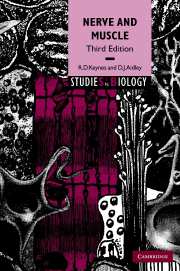Book contents
- Frontmatter
- Contents
- Preface
- Publishers note
- 1 Structural organization of the nervous system
- 2 Resting and action potentials
- 3 The ionic permeability of the nerve membrane
- 4 Membrane permeability changes during excitation
- 5 Voltage-gated ion channels
- 6 Cable theory and saltatory conduction
- 7 Neuromuscular transmission
- 8 Synaptic transmission in the nervous system
- 9 Skeletal muscles
- 10 The mechanism of contraction in skeletal muscle
- 11 Non-skeletal muscles
- Further reading
- References
- Index
8 - Synaptic transmission in the nervous system
Published online by Cambridge University Press: 05 June 2012
- Frontmatter
- Contents
- Preface
- Publishers note
- 1 Structural organization of the nervous system
- 2 Resting and action potentials
- 3 The ionic permeability of the nerve membrane
- 4 Membrane permeability changes during excitation
- 5 Voltage-gated ion channels
- 6 Cable theory and saltatory conduction
- 7 Neuromuscular transmission
- 8 Synaptic transmission in the nervous system
- 9 Skeletal muscles
- 10 The mechanism of contraction in skeletal muscle
- 11 Non-skeletal muscles
- Further reading
- References
- Index
Summary
The functioning of the nervous system depends largely on the interactions between its constituent nerve cells, and these interactions take place at synapses. In most cases synaptic transmission is chemical in nature, so that, as in neuromuscular transmission, the presynaptic cell releases a chemical transmitter substance which produces a response in the postsynaptic cell. There are a few examples of electrically transmitting synapses, which we shall consider briefly at the end of this chapter.
Acetylcholine is only one of a range of different neurotransmitters. Fig. 8.1 shows some of the variety found in the central nervous system. For a long time it was thought that any one cell would only release one neurotransmitter, but several cases where two of them are released at the same time are now known.
Different chemically transmitting synapses differ in the details of their anatomy, but some features are common to all of them. In the presynaptic terminal the transmitter substance is packaged in synaptic vesicles. The pre- and postsynaptic cells are separated by a synaptic cleft into which the contents of the vesicles are discharged. There are specific receptors for the neurotransmitter on the postsynaptic membrane.
Just as with the neuromuscular junction, our knowledge of how synapses work was greatly affected by the invention of the intracellular microelectrode. Much of the fundamental work with this technique was performed by J. C. Eccles and his colleagues on the spinal motoneurons of the cat, so it is with these that we shall begin our account of synapses between neurons.
- Type
- Chapter
- Information
- Nerve and Muscle , pp. 103 - 117Publisher: Cambridge University PressPrint publication year: 2001

